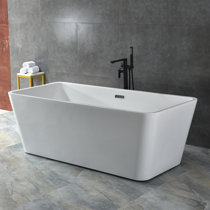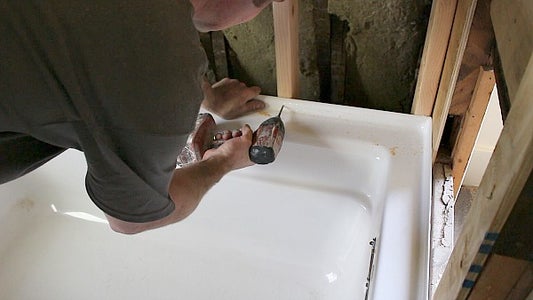Understanding Plumber's Essentials When Installing a Bathtub
Understanding Plumber's Essentials When Installing a Bathtub
Blog Article
We have come across this great article involving Installing A Bathtub down the page on the net and decided it made perfect sense to write about it with you here.

Setting up a tub isn't specifically rocket science, however it does call for solid plumbing, carpentry, as well as in some cases, tiling abilities. Changing an old tub with a brand-new one is additionally a reasonably difficult project. If the old bathtub is readily easily accessible, the job can move immediately; if you need to open up a wall to remove the old tub and place the brand-new tub, the task is a lot harder. In either instance, the job is within a house handyman's skills, although you will require a helper to vacate the old bathtub and embeded in the new one. Make sure you have actually qualified on your own for the job as well as fit attempting it. Rather than hiring a contractor to take over a halfway-completed project, it is far better to think about employing one before you begin. Chances are you might require a professional plumber to make tube links.
This post will certainly help you set up a brand-new bath tub in your shower room if you have actually currently acquired a brand-new bathtub and don't need to change the arrangement of your previous supply of water pipes.
Your tools and product list need to consist of the following:
Removing Old Taps
If you need to replace old faucets with brand-new ones as a part of your installation, then the first thing you should do is separate the water supply. After doing so, activate the faucets to drain any water continuing to be in the system. The process of getting rid of the existing taps can be fairly bothersome due to the restricted access that is commonly the situation.
Use a basin wrench (crowsfoot spanner) or a faucet device to undo the nut that links the supply pipes to the faucets. Have a towel ready for the staying water that will come from the pipelines. As soon as the supply pipelines have been removed, utilize the exact same device to loosen up the nut that holds the faucets onto the bath/basin. You will need to stop the single taps from turning throughout this procedure. When the taps have been removed, the holes in the bath/basin will certainly need to be cleaned up of any type of old securing compound.
Before moving on to fit the brand-new taps, compare the pipeline connections on the old faucets to the brand-new taps. If the old faucets are longer than the new faucets, then a shank adapter is needed for the brand-new taps to fit.
Suitable New Taps
If the tails of the brand-new taps are plastic, after that you will certainly need a plastic adapter to avoid damages to the thread. One end of the adapter fits on the plastic tail of the tap and the other end gives a link to the existing supply pipelines.
If you need to fit a monobloc, then you will certainly need decreasing couplers, which links the 10mm pipeline of the monobloc to the typical 15mm supply pipe.
Next, place the faucet in the placing opening in the bath/basin ensuring that the washing machines are in area between the tap as well as the sink. Protect the tap in place with the maker given backnut. As soon as the faucet is safely in position, the supply pipelines can be attached to the tails of the faucets. The taps can either be linked by using corrugated copper piping or with regular faucet ports. The former kind needs to be linked to the tap finishes first, tightening just by hand. The supply pipes can later on be linked to the other end. Tighten up both ends with a spanner after both ends have been attached.
Setting up the Bathtub
Utilizing the two wooden boards under its feet, position the bath tub in the needed placement. The wood boards are helpful in equally spreading the weight of the tub over the area of the boards as opposed to focusing all the weight onto four small points.
The next objective is to make certain that the bath tub is leveled all round. This can be attained by inspecting the level and adjusting the feet on the bathtub till the level reviews degree.
To set up taps, fit all-time low of the furthest flexible tap connector to the appropriate supply pipeline by making a compression join; then do the very same for the other tap.
Activate the water as well as check all joints and also new pipework for leakages and tighten them if essential. Fill up the bath tub and additionally check the overflow electrical outlet and the typical electrical outlet for leaks.
Ultimately, repair the bathroom paneling as described in the maker's user's manual. Tiling and sealing around the tub needs to wait until the bathtub has actually been used at the very least once as this will settle it into its final placement.
Preparing for the Installation
First of all, the supporting frame provided with the bath must be fitted (if called for) according to the supplier's guidelines. Next off, fit the faucets or mixer to the tub. When suitable the tap block, it is very important to make certain that if the tap features a plastic washer, it is fitted in between the bathroom and the taps. On a plastic bath, it is also sensible to fit a sustaining plate under the taps device to avoid strain on the bath tub.
Fit the adaptable tap adapters to the bottom of both faucets using 2 nuts and also olives (sometimes supplied with the tub). Fit the plug-hole outlet by smearing mastic filler round the sink outlet hole, and afterwards pass the electrical outlet through the hole in the bathroom. Utilize the nut supplied by the manufacturer to fit the plug-hole. Examine the plug-hole electrical outlet for an inlet on the side for the overflow pipe.
Next, fit completion of the versatile overflow pipe to the overflow outlet. Afterwards, screw the pipeline to the overflow face which ought to be fitted inside the bathroom. Make certain you make use of all of the provided washers.
Attach the catch to the bottom of the waste outlet on the bath tub by winding the string of the waste electrical outlet with silicone mastic or PTFE tape, and screw on the trap to the outlet. Attach the bottom of the overflow tube in a comparable manner.The bathroom ought to now prepare to be fitted in its final setting.
Tiling Around the Tub
In the area where the bath meets the tile, it is essential to seal the accompanies a silicone rubber caulking. This is very important as the installation can relocate sufficient to fracture an inflexible seal, creating the water to pass through the wall surface in between the bathroom and also the tiling, bring about complications with moisture as well as possible leakages to the ceiling below.
You can pick from a variety of coloured sealers to blend in your components and also fittings. They are offered in tubes and also cartridges, and are capable of sealing voids as much as a size of 3mm (1/8 inch). If you have a bigger gap to load, you can load it with spins of drenched newspaper or soft rope. Remember to always fill up the bath tub with water before sealing, to enable the motion experienced when the tub remains in usage. The sealant can fracture rather very early if you do not take into consideration this movement before sealing.
Alternatively, ceramic coving or quadrant ceramic tiles can be used to border the bathroom or shower tray. Plastic strips of coving, which are easy to use and cut to dimension, are additionally conveniently offered on the marketplace. It is recommended to fit the ceramic tiles making use of waterproof or water resistant sticky and grout.
Bathtub Installation
How Important Is A Bathtub To Your Home?
High-quality baths, showers, and other bathroom updates are necessary when considering a smart investment in your home. It’s a room that you go to every day and one that is constantly being used by guests.The bathroom is one of the top trafficked rooms in a home and also one of the most valuable in terms of home resale.
Install Piping Before Tub
You will be using your existing drain and waste vent system, but pipes required include the hot and cold water supply lines and a pipe leading to a shower head. A mixing valve and shower head are also needed. Air chambers may be required.
Position the Tub
Lower the tub into place so that the continuous flange fits against the wall studs and rests on 1’x4' or 2’x4' supports. Anchor the tub to the enclosure with nails or screws inserted through the flanges into the studs.
NOTE: Remember, bathtubs and shower stalls may require support framing. A bathtub filled with water is extremely heavy, so check building codes and framing support before installing the tub.
Assemble Drain Connections
Assemble the bathtub drain connections by connecting the tub overflow with the tub drain above the trap, not beyond it. The trap will have a compression fitting that screws over the arm of the overflow assembly.
Place a Pipe For the Shower Head
First, locate a brass female threaded winged fitting and attach it to a framing support via a screw or a nail. Then run a pipe up the wall for the shower head. Sweat or solder the other side of the brass fitting to the top of the pipe.
Attaching Hot and Cold Water Lines
Attach your water lines for both hot and cold by sweating these directly into the hot and cold ports of the mixing valve. The mixing valve will be how water enters the tub’s system, not by the pipes themselves.
Install the Spout
Extend a piece of 1/2 inch pipe, or whichever length is specified in the manufacturer’s instructions, for the tub spout. Sweat on a male threaded fitting at the end of the pipe or use a brass nipple of the proper length and a 1/2 inch cap.
NOTE: At this point you should have your rough-in plumbing work inspected before proceeding further.
Check For Leaks
Restore the water pressure and check the drain connection and the supply pipes for any sign of leaking.
estore the Bathroom Wall
Replace the wall with moisture-resistant drywall as a base for your wall covering. Seal the joints between the wall and your new tub with silicone caulk as protection against water seepage.
https://www.berkeys.com/2016/12/02/bathtub-installation-dallas/

We hope you enjoyed reading our excerpt on Tools You Need to Install a New Bathtub . Thanks for taking time to read our blog. For those who enjoyed reading our article kindly don't forget to pass it around. Thanks a bunch for your time. Please pay a visit to our blog back soon.
Urgent plumbing needs? Seek professionals. Report this page